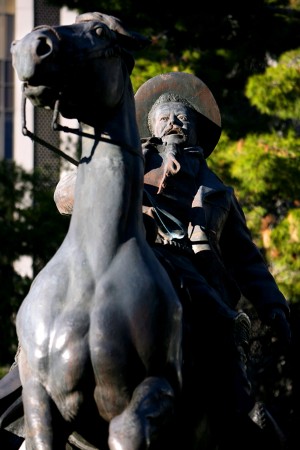

|
Source
Bronze was focus of controversy when erected in early '80s Tucson Oddity: Villa statue still riding high Phil Villarreal Arizona Daily Star Arizona Daily Star | Posted: Monday, January 10, 2011 12:00 am The Mexican Revolution was fought from 1910 to 1920, but political strife and violence continued for several more years. Nearly 1 million Mexicans fled the violence and settled in the United States. Tucson is a land of contradictions, so it's only fitting that a tribute to a polarizing figure stands at its heart. A bronze statue of Pancho Villa can be found at Veinte de Agosto Park, between West Broadway and West Congress Street downtown. [ I think this is in the county government building complex in Downtown Tucson ] The park owes its name to Tucson's Aug. 20, 1775, birthday. The statue has been controversial throughout its nearly 30-year life. Born José Doroteo Arango Arámbula in 1878, Villa adopted the pseudonym Francisco "Pancho" Villa. He was a general in the Mexican Revolution and was assassinated in 1923. A divisive icon not only during his life but to this day, some revere him as a hero who liberated the poor and disenfranchised, while others dismiss him as a thief and murderer of innocents. [ He was both. He definitely was a criminal. He definitely also helped overthrow the existing Mexican government which was a royal dictatorship. ] American soldiers pursued Villa after he and his rebels killed 18 Americans in Columbus, N.M., on March 9, 1916. The attack was in retaliation against the American government, which supported an enemy regime. Spanish-born sculptor Julian Martinez and foundry man Javier Portilla created the statue, which the Mexican government and Mexican media organization Agrupación Nacional Periodista gave to the state of Arizona on June 30, 1981. The statue survived two lawsuits that attempted to stop it from being erected. The Villa sculpture came to Tucson only after the Phoenix-area town of Guadalupe rejected it. [ Duh! What did you expect? The Town of Guadalupe is mostly made up of Yaqui Indians who came there as political refuges when they were chased out of Mexico by the government. ] The statue, 14 feet tall and weighing 7 tons, went on an 1,800-mile, two-week tour through U.S. and Mexican cities before settling here. Then-Mayor Lew Murphy refused to attend the dedication, which was attended by 1,000 supporters. A Pima Community College teacher - who asked not to be named in this story - staged the first of what he said would be annual protests of the statue in 1989. He would place 18 crosses in front of the statue to commemorate Villa's Columbus victims. A 1990 Star article described the teacher's second annual protest as a one-man event and said he was outnumbered by 10 counterprotesters supporting the statue. Discouraged by the turnout, the teacher never protested against Villa again. The city has continued to stand by Pancho, paying $2,000 for a sculptor to do a touch-up in 2006. Contact reporter Phil Villarreal at 573-4130 or pvillarreal@azstarnet.com |